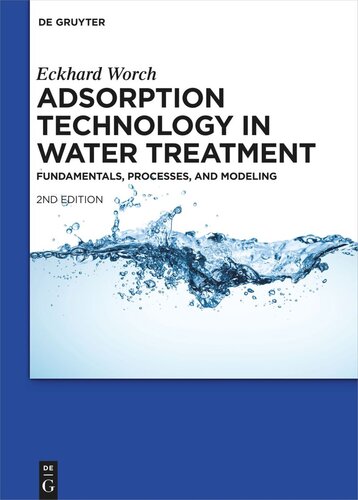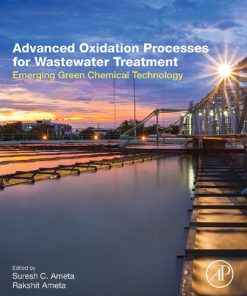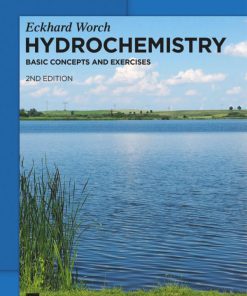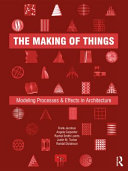Adsorption Technology in Water Treatment Fundamentals Processes and Modeling 1st Edition by Eckhard Worch ISBN 9783110715507 3110715503
$50.00 Original price was: $50.00.$25.00Current price is: $25.00.
Adsorption Technology in Water Treatment Fundamentals Processes and Modeling 1st Edition by Eckhard Worch – Ebook PDF Instant Download/Delivery: 9783110715507 ,3110715503
Full download Adsorption Technology in Water Treatment Fundamentals Processes and Modeling 1st Edition after payment

Product details:
ISBN 10: 3110715503
ISBN 13: 9783110715507
Author: Eckhard Worch
Adsorption Technology in Water Treatment Fundamentals Processes and Modeling 1st Edition Table of contents:
1 Introduction
1.1 Basic concepts and definitions
1.1.1 Adsorption as a surface process
1.1.2 Some general thermodynamic considerations
1.1.3 Adsorption versus absorption
1.1.4 Mathematical description of adsorption processes: The structure of the adsorption theory
1.2 Engineered adsorption processes in water treatment
1.2.1 Overview
1.2.2 Drinking water treatment
1.2.3 Wastewater treatment
1.2.4 Hybrid processes in water treatment
1.3 Natural sorption processes in water treatment
2 Adsorbents and adsorbent characterization
2.1 Introduction and adsorbent classification
2.2 Engineered adsorbents
2.2.1 Activated carbons
2.2.2 Polymeric adsorbents
2.2.3 Oxidic adsorbents
2.2.4 Synthetic zeolites
2.3 Natural and low-cost adsorbents
2.4 Geosorbents in environmental compartments
2.5 Adsorbent characterization
2.5.1 Densities
2.5.2 Porosities
2.5.3 External surface area
2.5.4 Internal surface area
2.5.5 Pore-size distribution
2.5.6 Surface chemistry
2.6 Practice-oriented test methods for assessing the performance of adsorbents
3 Adsorption equilibrium I: General aspects and single-solute adsorption
3.1 Introduction
3.2 Experimental determination of equilibrium data
3.2.1 Basics
3.2.2 Practical aspects of isotherm determination
3.3 Isotherm equations for single-solute adsorption
3.3.1 Classification of single-solute isotherm equations
3.3.2 Irreversible isotherm and one-parameter isotherm
3.3.3 Two-parameter isotherms
3.3.4 Three-parameter isotherms
3.3.5 Isotherm equations with more than three parameters
3.4 Prediction of isotherms
3.5 Temperature dependence of adsorption
3.6 Slurry adsorber design
3.6.1 General aspects
3.6.2 Single-stage adsorption
3.6.3 Two-stage adsorption
3.7 Application of isotherm data in kinetic or breakthrough curve models
4 Adsorption equilibrium II: Multisolute adsorption
4.1 Introduction
4.2 Experimental determination of equilibrium data
4.3 Overview of existing multisolute adsorption models
4.4 Multisolute isotherm equations
4.5 The ideal adsorbed solution theory (IAST)
4.5.1 Basics of the IAST
4.5.2 Solution to the IAST for given equilibrium concentrations
4.5.3 Solution to the IAST for given initial concentrations
4.5.4 Solution to the IAST for the special case of linear single-solute isotherms
4.6 The pH dependence of adsorption: A special case of competitive adsorption
4.7 Adsorption of background dissolved organic matter (DOM)
4.7.1 The significance of DOM in activated carbon adsorption
4.7.2 Modeling of DOM adsorption: The fictive component approach (adsorption analysis)
4.7.3 Competitive adsorption of micropollutants and DOM
4.8 Slurry adsorber design for multisolute adsorption
4.8.1 Basics
4.8.2 DOM adsorption
4.8.3 Competitive adsorption of micropollutants and DOM
4.8.4 Nonequilibrium adsorption in slurry reactors
4.9 Special applications of the fictive component approach
5 Adsorption kinetics
5.1 Introduction
5.2 Mass transfer mechanisms
5.3 Experimental determination of kinetic curves
5.4 Mass transfer models
5.4.1 General considerations
5.4.2 Film diffusion
5.4.3 Surface diffusion
5.4.4 Pore diffusion
5.4.5 Combined surface and pore diffusion
5.4.6 Simplified intraparticle diffusion model (LDF model)
5.4.7 Reaction kinetic models
5.4.8 Adsorption kinetics in multicomponent systems
5.5 Practical aspects: Slurry adsorber design
6 Adsorption dynamics in fixed-bed adsorbers
6.1 Introduction
6.2 Experimental determination of breakthrough curves
6.3 Fixed-bed process parameters
6.4 Material balances
6.4.1 Types of material balances
6.4.2 Integral material balance
6.4.3 Differential material balance
6.5 Practical aspects
6.5.1 Introduction
6.5.2 Typical operating conditions
6.5.3 Fixed-bed versus batch adsorber
6.5.4 Multiple adsorber systems
7 Fixed-bed adsorber design
7.1 Introduction and model classification
7.2 Scale-up methods
7.2.1 Mass transfer zone model
7.2.2 Length of unused bed model
7.2.3 Rapid small-scale column test
7.3 Equilibrium column model
7.4 Complete breakthrough curve models
7.4.1 Introduction
7.4.2 Homogeneous surface diffusion model
7.4.3 Constant pattern approach to the HSDM
7.4.4 Linear driving force model
7.4.5 Comparison of HSDM and LDF model
7.4.6 Simplified breakthrough curve models with analytical solutions
7.5 Determination of model parameters
7.5.1 General considerations
7.5.2 Single-solute adsorption
7.5.3 Competitive adsorption in defined multisolute systems
7.5.4 Competitive adsorption in complex systems of unknown composition
7.6 Special applications of breakthrough curve models
7.6.1 Micropollutant adsorption in the presence of background organic matter
7.6.2 Biologically active carbon filters
8 Desorption and reactivation
8.1 Introduction
8.2 Physicochemical regeneration processes
8.2.1 Desorption into the gas phase
8.2.2 Desorption into the liquid phase
8.3 Reactivation
9 Geosorption processes in water treatment
9.1 Introduction
9.2 Experimental determination of geosorption data
9.3 The advection-dispersion equation and the retardation concept
9.4 Determination of the retardation factor from experimental breakthrough curves
9.5 Breakthrough curve modeling
9.5.1 Introduction and model classification
9.5.2 Local equilibrium model
9.5.3 Linear driving force model
9.5.4 Extension of the local equilibrium model
9.6 Combined sorption and biodegradation
9.6.1 General model approach
9.6.2 Special case: Sorption and biodegradation of dissolved organic matter
9.7 The influence of pH and DOM on geosorption processes
9.7.1 pH-dependent sorption
9.7.2 Influence of DOM on micropollutant sorption
9.8 Practical aspects: Prediction of subsurface solute transport
9.8.1 General considerations
9.8.2 Prediction of sorption coefficients
9.8.3 Prediction of the dispersivity
10 Appendix
10.1 Conversion of Freundlich coefficients
10.2 Alternative solution equations of the ideal adsorbed solution theory
10.3 Theoretical basics of the simplified equivalent background compound model
10.4 Evaluation of surface diffusion coefficients from experimental data
10.5 Constant pattern solution to the homogeneous surface diffusion model
10.6 Viscosity of water
Nomenclature
Preliminary notes
English alphabet
Greek alphabet
Abbreviations
References
Index
People also search for Adsorption Technology in Water Treatment Fundamentals Processes and Modeling 1st Edition:
Tags: Eckhard Worch, Adsorption Technology, Water Treatment, Modeling
You may also like…
Technique - Water Treatment
Uncategorized
Earth Sciences - Geochemistry
Hydrochemistry Basic Concepts and Exercises 2ed 2nd Edition Eckhard Worch
Science (General)
Uncategorized
Geospatial Technology for Environmental Hazards Modeling and Management in Asian Countries
Arts - Architecture
The Making of Things Modeling Processes and Effects in Architecture 1st Edition Frank Jacobus
Chemistry - Chemistry - General & Miscellaneous
Hydrochemistry Basic Concepts and Exercises 2nd Edition Eckhard Worch











